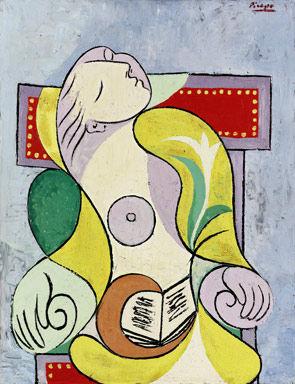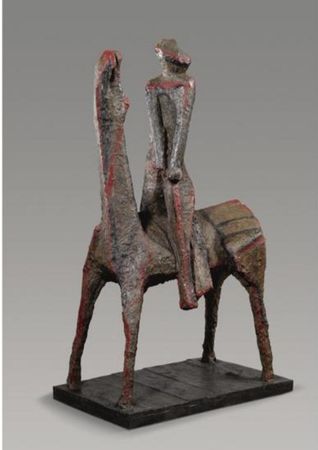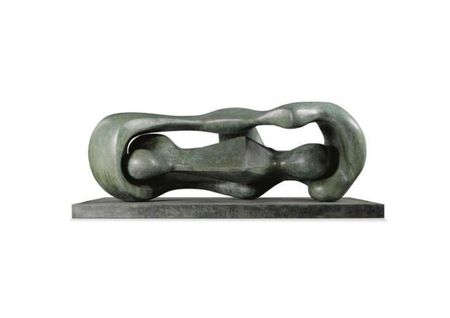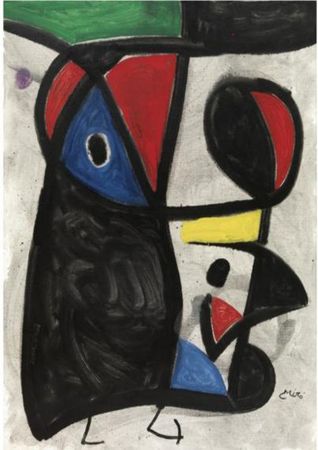Major Picasso Portrait of His Mistress and Muse to Lead Sotheby's Sale in February
Pablo Picasso (1881-1973), La Lecture, 1932. Est: £12-18 million / $18.6- $27.9 million. Photo: Sotheby's
LONDON.- Sotheby’s forthcoming Evening sale of Impressionist and Modern Art, to be held in London on Tuesday, 8th February 2011, will be led by a major painting by Pablo Picasso, depicting Marie-Thérèse Walter, the woman who transformed both his life and his art. Picasso’s La Lecture of 1932 (estimated at £12,000,000-18,000,000 / US$18,570,000 - $27,850,000*) relates closely to the legendary painting Le Rêve (The Dream), painted in the same year, and ranks among the stars of the big season of sales that will take place in London from February 8th to 17th.
Helena Newman, Sotheby’s Chairman, Impressionist & Modern Art, Europe, comments: “Last February at Sotheby’s in London saw the record-breaking sum of £65 million paid for Giacometti’s L’Homme qui marche I. Following on from that, and from the successes in the field of Impressionist and Modern Art that continued throughout the year, we are now delighted to present a sale that will appeal to the tastes of today’s ever expanding global market.”
The story of Picasso’s first encounter with Marie-Thérèse, and their subsequent love affair, are among the most compelling in 20th-century art history. Marie-Thérèse was just 17 when Picasso first introduced himself to her. She was naïve and completely oblivious of the fame that already surrounded the stranger who approached her as she was leaving the Paris Metro one day in 1927. “I was an innocent girl,” she later recalled. “I knew nothing – either of life or of Picasso… I had gone to do some shopping at the Galeries Lafayette, and Picasso saw me leaving the Metro. He simply took me by the arm and said: ‘I am Picasso! You and I are going to do great things together.’” The couple’s relationship was kept a well-guarded secret for many years, both on account of the fact that Picasso was then still married (to Olga Khokhlova, a Russian-Ukrainian dancer he had met on tour with Diaghilev) and because of Marie-Thérèse’s age. Until the period in which this work was painted, Marie- Thérèse only ever appeared in Picasso’s works in code, her features often embedded in the background of his paintings. But by the end of 1931, Picasso could no longer repress the creative impulse that his lover inspired, and over Christmas and New Year 1931 and ‘32, Marie- Thérèse emerged, for the first time, in fully recognisable, languorous, form.
It was then, in January 1932, that this picture was painted. Marie-Thérèse’s potent mix of physical attractiveness and sexual naivety had an intoxicating effect on Picasso, and his rapturous desire for her brought about a number of images that are among the most sought after of his long career. Indeed, La Lecture is very similar, in terms of composition, to the famous Le Rêve, the history and importance of which has been widely reported. The two works were painted just days apart, and were soon after exhibited alongside each other in the major Picasso retrospective Exposition Picasso, held from June to October 1932 at Galerie Georges Petit in Paris, and at the Kunsthaus in Zurich.
It was with the exhibition that – for the first time – Picasso’s secret came out. Olga, upon seeing Picasso’s numerous references to a specific face that was clearly not her own, was suddenly alerted to the presence of a new woman in her husband’s life.
The painting enjoys an illustrious history, having belonged to a series of celebrated American collectors, including Keith Warner, David Lloyd Kreeger and James W. Alsdorf. It has not been seen in Europe since the 1932 exhibition.
SCULPTURE
2010 was an exceptional year for sculpture, with record-breaking prices seen across the board. Chief among these was Giacometti’s £65 million L’Homme qui marche I, sold at Sotheby’s in February last year and establishing a record for any work of art sold at auction. Given the strength of the sculpture market, this February’s sale includes a fittingly strong selection of sculpture, with works by Marini, Giacometti, Moore and Maillol.
Marino Marini (1901-1980), L’Idea del cavaliere, 1955. Est: £3.7 – 4.5 million. Photo: Sothebys
Just as La Lecture ranks high in the oeuvre of Picasso, so too Marino Marini’s) is one of the most important works by the artist ever to come to the market.
Remarkable both in terms of its monumental scale (it measures 220cm / 865/8 in. high) and because it is hand-painted by the artist, this extraordinary 1955 bronze of the Marino’s most famous subject of the horse and rider is an exceptional example of the his achievements in this area.
L’Idea del cavliere is one of an edition of four bronzes of the subject. Others from the series are at the Museo Marino Marini in Milan and San Diego Museum of Art. In 1956, Marini carved a unique painted wood version, which was sold at Sotheby’s New York in May 2007 for $7 million - a record for the artist at the time.
Alberto Giacometti’s bronze Grand buste de Diego avec bras, 1957 (est: £3.5-5 million) belongs to a celebrated series of the artist’s sculptural portraits of his younger brother Diego, and is complemented by the oil on canvas Diego, 1958 (est: £3-5 million), which is also to be offered. Diego acted as the primary model for Alberto’s numerous variations on the theme of head and bust sculptures throughout the 1950s and 60s. Grand buste de Diego avec bras is a prime example from this period.
Alberto Giacometti (1901-1966), Grand buste de Diego avec bras, 1957. Est: £3.5-5 million. Photo: Sothebys
Giacometti’s paintings were also an important part of his work at this time: “There is no difference between painting and sculpture.' I have been practicing them both indifferently, each helping me to do the other. In fact, both of them are drawing, and drawing has helped me to see.” (Alberto Giacometti, quoted in Yves Bonnefoy, Alberto Giacometti, A Biography of His Work, Paris, 1991, p. 436)
In his dramatic and haunting oil on canvas Diego, his brother’s slender head is juxtaposed with his broad, voluminous bust. While this portrait of the artist’s brother reflects the influence of the post-war Existentialist movement with its connotations of isolation of the
individual within a large solitary space, as well as Giacometti’s own reworking of themes from his Surrealist past, both of the remarkable works by the artist to be offered in the sale reflect the intense relationship the two brothers enjoyed throughout their lives.
Henry Moore, perhaps the most prominent of British sculptors of the 20th century, continues to hold strong appeal for collectors around the world. His important monumental bronze Reclining Connected Forms of 1969 incorporates two recurring themes in Moore’s art: a dichotomy between internal and external forms, and the theme of mother and child. The work, other casts of which are in major museums around the world, is estimated at £1,500,000-2,500,000.
Henry Moore (1898-1986), Recling conntected forms, 1969. Est. £1,500,000-2,500,000. Photo: Sotheby's
IMPRESSIONIST AND POST-IMPRESSIONIST WORKS
Exemplary works by Claude Monet, Pierre-Auguste Renoir, Édouard Manet, and Paul Signac are highlights of the Impressionist and Post-Impressionist works to be offered, each marking new departures of their own kind.
Claude Monet (1840-1925), Argenteuil, fin d’après-midi, 1872. Est: £3.5-4.5 million. Photo: Sotheby's
Claude Monet’s Argenteuil, fin d’après-midi, 1872 (est: £3.5-4.5 million), painted at the dawn of the Impressionist movement in the early 1870s, is one of Monet’s first major landscapes of his new home just outside of Paris. Depicting the leisure activity of the time and especially of this particular town, the present work was one of Monet’s first major compositions on the theme of boats on the water and the popular promenade of Argenteuil. Monet devoted several canvases to the subject in the early 1870s, delighting with his fellow painters in representing the symbols of progress that sprung from this period of prosperity due to advances in industry, technology and the standards of living. As was characteristic of his best Impressionist landscapes, Monet painted this work on location, setting up his easel along the river bank in order to capture the fleeting effects of light and shadow glistening on the surface of the water. Its sale coincides with the close of a dazzling exhibition of Monet’s work at the Grand Palais in Paris, which attracted record numbers of visitors and reaffirmed the artist’s towering status among the greatest painters of all times.
Pierre-Auguste Renoir (1841-1919), La Lecture, deux femmes aux corsages rouge et rose. Est: £2-3million. Photo: Sotheby's
Pierre-Auguste Renoir’s La Lecture, deux femmes aux corsages rouge et rose (est: £2-3million) is undoubtedly among the most successful of Renoir’s late large-scale works. It comes to the market with an exceptional history: in 1954, the painting was sold at the Galerie Charpentier in Paris to a private English collector in whose family possession it has remained until now. Its first museum showing since 1938 was in the Philadelphia Museum of Art's landmark exhibition Renoir in the 20th Century held in 2010.
A tender and harmonious portrait, La Lecture is one of the most beautiful, touching and serene of Renoir's late works. Intimate and filled with subtle sensuality, the painting lyrically demonstrates Renoir's masterly ability to portray his figures in an entirely natural way. In later years, success allowed him to paint the sitters who most interested and touched him, especially his family and those with whom he chose to be in contact. Here he magically catches an intimate moment in which two beautiful young women, oblivious to all around them, even the artist, are entranced by the words they are reading.
Paul Signac (1863-1935), Venise. La Salute Vert, 1908. Est: £1.8-2.5 million. Photo: Sotheby's
Paul Signac’s oil on canvas Venise. La Salute Vert, 1908 (est: £1.8-2.5 million) was inspired by the artist’s visit to Venice following a fascination with the city partly influenced by John Ruskin’s popular The Stones of Venice. Painted in the same year as Monet’s series of paintings of Venice, mosaic-like brushwork is here contrasted with dabs of bright green, blue, pink and yellow pigment, giving the scene the shimmering effect. Also to be offered is Signac’s oil on canvas Barfleur, 1931 (est: £900,000-£1.2 million), depicting the port of Barfleur in Normandy. So delighted by this region, Signac bought a little fisherman’s house with a view of the harbour in 1931 - a view of which he never tired of painting.
Édouard Manet (1832 - 1883), Jeune fille en déshabillé, 1882. Est: £1-1.5 million. Photo: Sotheby's
Édouard Manet’s beautifully rendered pastel on canvas Jeune fille en déshabille, 1882 (est: £1-1.5 million) was previously owned by one of the first American collectors of Impressionist art, Mrs Thomas A. Scott, the wife of the president of the Pennsylvania Railroad. Bought on the advice of the Impressionist artist Mary Cassatt, the pastel depicts a model thought to bear resemblance to the actress Ellen Andrée, who is also believed to be the model for another Manet pastel in the collection of the Louvre and who famously sat for Degas’ L’Absinthe. As in some of Degas’s most sensitive pastel portraits, the model’s delicate beauty here is exquisitely captured. This evocative pastel featured in the first posthumous retrospective of Manet’s work in Paris in 1884.
SURREALISM
Great works by the key names in Surrealism continue to attract strong competition. A group of five major works in the evening sale – by artists Magritte, Miro and Tanguy - will be complemented by Salvador Dalí’s masterpiece Portrait de Paul Eluard (est. £3.5-5 million), as well as important works by Joan Miro, Max Ernst and Jean Arp which are to be offered in the single owner sale Looking Closely: A Private Collection, on the evening of 10th February 2011.
Of note in the sale on the 8th February are four gouaches and an oil painting by René Magritte. The oil, La Joconde (est: £1.8-2.5 million) is a remarkable example of Magritte's mature painting, uniting some of the best known elements of the artist's iconography: the curtain, the bell and the sky, all depicted against a neutral background. The composition is dominated by the monumental curtains, through which Magritte presents a juxtaposition of opposites – the paradox of concealing and revealing, and the contrast between the natural and the man-made, between interior and exterior settings. By confronting these contrasted elements, Magritte evokes the essential surrealist paradigm of questioning the significance and purpose we attribute to various objects, and creating new meanings by placing these objects in new and unexpected contexts.
René Magritte (1898 - 1967), La Joconde. Est: £1.8-2.5 million. Photo: Sotheby's
Two of the Magritte gouaches in the sale depict the artist’s single most iconic motif, the bowler-hatted man: Le Maître d’École, 1955 and Les Tambours de la Mort, circa 1965 (each estimated at £800,000-£1.2 million).
René Magritte (1898 - 1967), Le Maître d’École, 1955. Est. £800,000 - 1,200,000. Photo: Sotheby's
René Magritte (1898 - 1967), Les Tambours de la Mort, circa 1965. Est. £800,000 - 1,200,000. Photo: Sotheby's
Joan Miró is represented in the sale with a striking example of the artist’s late works, Femme, 1978 (est: £900,000-£1.2 million), which features the characteristic iconography that occupied the artist throughout his career. For Miró, women, birds, stars, the moon, the sun, night and dusk formed a poetic language, and the present work shows his style verging between figuration and abstraction. While taking a recognisable image as his starting point, the artist builds his composition using a pictorial lexicon of signs and symbols.
Joan Miró (1893 - 1983), Femme, 1978. Est: £900,000-£1.2 million. Photo: Sotheby's
Yves Tanguy is also represented in the sale, with his oil on canvas Lumen, 1949 (est: £350,000-450,000), which is populated by evocative biomorphic shapes and is characteristic of the artist’s enigmatic landscapes and abandoned fields, representing an alternative, fantastic world.
Yves Tanguy (1900 - 1955), Lumen, 1949. Est: £350,000-450,000. Photo: Sotheby's
GERMAN ART
Prime examples of German Art have become ever-more hotly contested over recent years, with works by artists such as Lyonel Feininger, Alexej von Jawlensky and Emil Nolde appearing increasingly regularly among the top-selling works in the Impressionist and Modern field. Each of these artists is represented in February’s sale, with a strong, colourful work by Lyonel Feiniger – Raddampfer am Landungssteg, estimated at £1,000,000-£1,200,000 - heading the group.
Lyonel Feiniger (1871 - 1956), Raddampfer am Landungssteg. Estimate £1,000,000-£1,200,000. Photo: Sotheby's
This splendid painting has not been seen in public for over 30 years. The painting’s first recorded owner was the famed banker, politician and art collector Hugo Simon. It has been part of the collection assembled by Fritz Katz of New York since 1972 and is in wonderfully fresh condition.
Painted in 1912, at the height of Feininger’s involvement with Die Brücke, Raddampfer am Landungssteg shows the artist redefining his style, referencing the aesthetic of French Cubism, but at the same time applying these ideas to grander subjects and attempting to synthesise rhythms, forms, perspectives and colours in a way that was uniquely his own. “My ‘cubism’, to so miscall it, for it is the reverse of the French cubists’ aims..., [is], if it must have a name, ‘prism-ism’ “.
The sale will also feature two works by Emil Nolde (1867-1956), both of which come to auction directly from the artist’s family. The first, Zinnen und Stockrosen (Zinnias and Hollyhocks, 1938, est: £900,000-£1,400,000) is a powerful example of Nolde’s great series of flower paintings. His intensive preoccupation with the subject has been seen as a reflection of his continuing interest in the work of Van Gogh, whose bright colours, bold brushstrokes and magnificent textures are echoed here, while at the same time evincing Nolde’s own emotional admiration for the beauty of nature. Within the gamut of nature, another subject that preoccupied Nolde throughout his career was that of the sea. Űberschleierte Sonne (Veiled Sun, 1950, est: £500,000-700,000) is a powerful example of the artist’s breathtaking seascapes.
Emil Nolde (1867-1956), Zinnen und Stockrosen (Zinnias and Hollyhocks), 1938. Est. £900,000-£1,400,000. Photo: Sotheby's
Emil Nolde (1867-1956), Űberschleierte Sonne (Veiled Sun), 1950. Est. £500,000-700,000. Photo: Sotheby's
FURTHER WORKS BY PICASSO
In addition to La Lecture (mentioned above), the sale also includes six further works by Picasso, each from a different period in his career. Among these is Portrait d’Olga of 1923 - an exquisite portrait of the artist's first wife, Olga Khokhlova, painted in Picasso's Neo-Classical style of the early 1920s. The term 'Neo-Classical' refers to the artist's conscious affiliation with the art of the Greek and Roman world and his attempt to incorporate a linear precision and clear draughtsmanship into his art.
Pablo Picasso (1881-1973), Portrait d’Olga, 1923. Est: £1.3 – 1.8 million. Photo: Sotheby's
Olga Khokhlova (1891-1955) was a Ukranian-Russian ballerina who had met Picasso in the spring of 1917, while working for Sergei Diaghilev’s Ballets Russes. Picasso arrived in Rome in 1917 to join Diaghilev’s troupe, working on sketches for the costumes and stage sets. While there he met and immediately fell in love with the beautiful and sophisticated Olga, following her and the troupe to Madrid and Barcelona. Estimated at £1.3 – 1.8 million, this tenderly executed portrait represents one of the last times Olga’s image appeared in Picasso’s art. The delicate rendering of Olga’s features here shows Picasso’s enduring admiration for his first wife and for her inner, as well as her physical, beauty.
Picasso is further represented in the sale by three other works. The first of these, Nu couché of 1967 (est: £2.5-3.5 million) is part of a series inspired by the final love of the artist's life, Jacqueline Roque. With Jacqueline, the artist explored the theme of artist and model, executing a number of variations on this subject from 1963 onwards. As Picasso continued to return to this subject over the following years, the painter depicted in his compositions gradually occupied less of the canvas. In some works, such as Nu couché of 1967, the figure of the artist has been entirely eliminated, and the large figure of the nude female model becomes the sole subject of the composition.
Pablo Picasso (1881-1973), Nu couché, 1967. Est:£2.5-3.5 million. Photo: Sotheby's
The two other works by Picasso include Compotier et verres of 1943 (est: £600,000-800,000) and Tête d’homme of 1969 - a bold, expressive portrait, in which the artist the comes face to face with looming mortality (est: £900,000-1,200,000).
Pablo Picasso (1881-1973), Compotier et verres, 1943. Est:£900,000-1,200,000. Photo: Sotheby's
Pablo Picasso (1881-1973), Tête d’homme , 1943. Est:£900,000-1,200,000. Photo: Sotheby's

/https%3A%2F%2Fprofilepics.canalblog.com%2Fprofilepics%2F1%2F0%2F100183.jpg)






















/http%3A%2F%2Fstorage.canalblog.com%2F69%2F57%2F119589%2F64370738_p.jpg)
/http%3A%2F%2Fstorage.canalblog.com%2F36%2F03%2F119589%2F64361206_p.jpg)
/http%3A%2F%2Fstorage.canalblog.com%2F56%2F92%2F119589%2F61703506_p.jpg)
/http%3A%2F%2Fstorage.canalblog.com%2F34%2F00%2F119589%2F61670151_p.jpg)